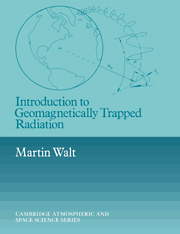Book contents
- Frontmatter
- Contents
- Preface
- List of symbols
- Useful constants
- Geophysical quantities
- Energy equivalents
- 1 The Earth's radiation belts
- 2 Charged particle motion in magnetic and electric fields
- 3 The geomagnetic field
- 4 Adiabatic invariants
- 5 Particle fluxes, distribution functions and radiation belt measurements
- 6 Particle diffusion and transport
- 7 Diffusion in pitch angle
- 8 Diffusion in the L coordinate or radial diffusion
- 9 Summary and comments
- Appendix A Summary of frequently used formulas
- Appendix B Gyration, bounce and drift frequencies in a dipole field
- References
- Index
4 - Adiabatic invariants
Published online by Cambridge University Press: 21 September 2009
- Frontmatter
- Contents
- Preface
- List of symbols
- Useful constants
- Geophysical quantities
- Energy equivalents
- 1 The Earth's radiation belts
- 2 Charged particle motion in magnetic and electric fields
- 3 The geomagnetic field
- 4 Adiabatic invariants
- 5 Particle fluxes, distribution functions and radiation belt measurements
- 6 Particle diffusion and transport
- 7 Diffusion in pitch angle
- 8 Diffusion in the L coordinate or radial diffusion
- 9 Summary and comments
- Appendix A Summary of frequently used formulas
- Appendix B Gyration, bounce and drift frequencies in a dipole field
- References
- Index
Summary
Introduction
The guiding center equations of motion developed in Chapter 3 are an enormous improvement over the Lorentz force equation for describing the long-term behavior of particles in inhomogeneous magnetic and electric fields. When applied to the Earth's field, they clarify the cause of magnetic trapping. However, the drift and mirroring force equations do not allow long-range prediction of particle location, particularly in fields without axial symmetry. For example, without numerically integrating the guiding center equations over many bounces and over many degrees of longitudinal drift, a procedure likely to introduce errors, it is not possible to predict where a particle launched on a field line over Africa will be when it has drifted over the United States.
Missing in the theory described thus far are ‘constants of motion’ analogous to the conservation of energy, momentum and angular momentum in mechanical systems. Adiabatic invariants fill the role of the required constants of motion, and their use is essential in research on trapped radiation.
Fortunately, in mechanical systems undergoing periodic motion in which the forces change very slightly over a period, approximate constants do exist. These are called ‘adiabatic invariants’, implying that their values are constant provided the forces directing the motion are altered infinitely slowly.
- Type
- Chapter
- Information
- Introduction to Geomagnetically Trapped Radiation , pp. 36 - 58Publisher: Cambridge University PressPrint publication year: 1994



